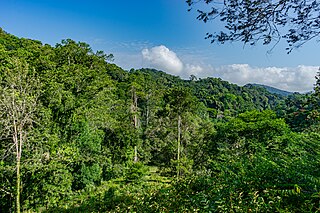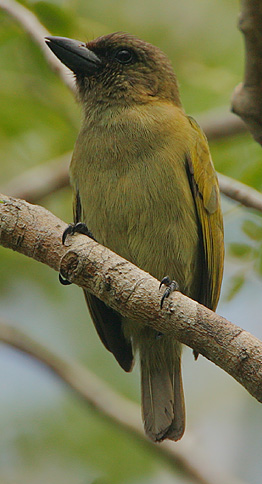
The bushshrikes are smallish passerine birds. They were formerly classed with the true shrikes in the family Laniidae, but are now considered sufficiently distinctive to be separated from that group as the family Malaconotidae, a name that alludes to their fluffy back and rump feathers.

The black-crowned tchagra is a bushshrike. This family of passerine birds is closely related to the true shrikes in the family Laniidae, and was once included in that group.
The Nguru Mountains are a mountain range in Morogoro Region, Tanzania, Africa. They are part of the Eastern Arc Mountains. The mountains are predominantly covered with rainforest, home to 83 species of birds and African violets. Several forest reserves are located in the mountains.

The Amani Forest Reserve, officially listed as Amani Nature Forest Reserve is a protected area located the Muheza and Korogwe Districts in the Tanga Region of Tanzania. The nature reserve was established in 1997 in order to preserve the unique flora and fauna of the East Usambara Mountains. The East and West Usambara Mountains are a biodiversity hotspot. The Amani Nature Reserve includes tropical cloud forest habitats.

The brubru is a species of bushshrike found in most of Sub-Saharan Africa. It is the only member of the genus Nilaus.
The long-billed forest warbler, also known as the long-billed tailorbird, is a songbird of the family Cisticolidae, formerly part of the "Old World warbler" assemblage. It is found in Tanzania and Mozambique. Its natural habitat is subtropical or tropical moist montane forests. It is threatened by habitat destruction.

The grey-headed bushshrike, colloquially known as the ghostbird, is a species of passerine bird in the family Malaconotidae. It is widespread throughout sub-Saharan Africa, although relatively absent in Central Africa and the interior of southern Africa. It is the most widespread species of its genus, which consists of large bushshrikes with massive bills and mournful hooting calls. It occurs sparsely in a range of wooded habitats, though typically in denser vegetation within dry or moist savannah. The monogamous pairs occupy woodland with sufficient cover. They are sedentary, but will undertake limited post-breeding movements.

The green-breasted bushshrike or gladiator bushshrike is a species of bird in the family Malaconotidae. It is found in the Cameroonian Highlands forests. With a total length of 25 to 28 cm and a body mass of around 99 g (3.5 oz) this may be the largest of the Malaconotidae.
The Mount Kupe bushshrike is a species of bird in the family Malaconotidae. It was previously thought to be endemic to Cameroon, where it is found in the Bakossi Forest Reserve and in particular on Mount Kupe, where it has been known to attract ecotourists. In 2011 it was reported to be present in two sites in south east Nigeria.

Lagden's bushshrike is a bird species in the bushshrike family (Malaconotidae) native to Africa. It is a stocky bird with yellow or orange-yellow underparts, olive green upperparts, a grey head and heavy bill. Two subspecies are recognised, one found in west Africa and one in central Africa.

Monteiro's bushshrike is a species of bird in the bush-shrike family (Malaconotidae).

The gorgeous bushshrike is a species of bird in the family Malaconotidae. It is also known as the four-coloured bushshrike. Some use the name gorgeous bushshrike for the subspecies Telophorus viridis viridis only.

The green barbet is a species of bird in the Lybiidae family. It is found in Kenya, Tanzania, Malawi, Mozambique and South Africa. It occurs in forests from sea level to 1,800 metres (5,900 ft). Its isolated populations are vulnerable to forest clearing.

The wildlife of Rwanda comprising its flora and fauna, in prehistoric times, consisted of montane forest in one third the territory of present-day Rwanda. However, natural vegetation is now mostly restricted to the three national parks and four small forest reserves, with terraced agriculture dominating the rest of the country.

The black-fronted bushshrike is a passerine bird of the bushshrike family, Malaconotidae. It inhabits forests mainly in East Africa. It forms a superspecies with the many-colored bushshrike and the two are sometimes considered to be a single species.
The dark batis is a small passerine bird belonging to the genus Batis in the wattle-eye family, Platysteiridae. It is found in highland forest in south-west Tanzania, northern Malawi, and northern Mozambique. These birds were formerly thought to be forest batises but in 2006 were described as a new species based on differences in morphology and mitochondrial DNA from those birds in northern Tanzania and Kenya.
Mikumi National Park is a national park near Morogoro, Tanzania with an area of 3,230 km2 (1,250 sq mi) that was established in 1964. It is the fourth largest in the country. The park is crossed by Tanzania's A-7 highway.

Tanzania contains some 20 percent of the species of Africa's large mammal population, found across its reserves, conservation areas, marine parks, and 17 national parks, spread over an area of more than 42,000 square kilometres (16,000 sq mi) and forming approximately 38 percent of the country's territory. Wildlife resources of Tanzania are described as "without parallel in Africa" and "the prime game viewing country". Serengeti National Park, the country's second largest national park area at 14,763 square kilometres (5,700 sq mi), is located in northern Tanzania and is famous for its extensive migratory herds of wildebeests and zebra while also having the reputation as one of the great natural wonders of the world. The Ngorongoro Conservation Area, established in 1959, is a UNESCO World Heritage Site and inhabited by the Maasai people. Its Ngorongoro Crater is the largest intact caldera in the world.

The South Malawi montane forest-grassland mosaic is a montane grasslands and shrublands ecoregion of Tanzania, Malawi, Mozambique, and Zambia.
The Ukaguru Mountains are a mountain range in central Tanzania. The mountains are in Morogoro region, east of Tanzania's capital Dodoma. The mountains are named for the Kaguru people. The Ukaguru Mountains are part of the Eastern Arc Mountains, and are home to a biodiverse community of flora and fauna with large numbers of endemic species.














